Fantasy Books
The Sword and Planet of Edgar Rice Burroughs, Part I
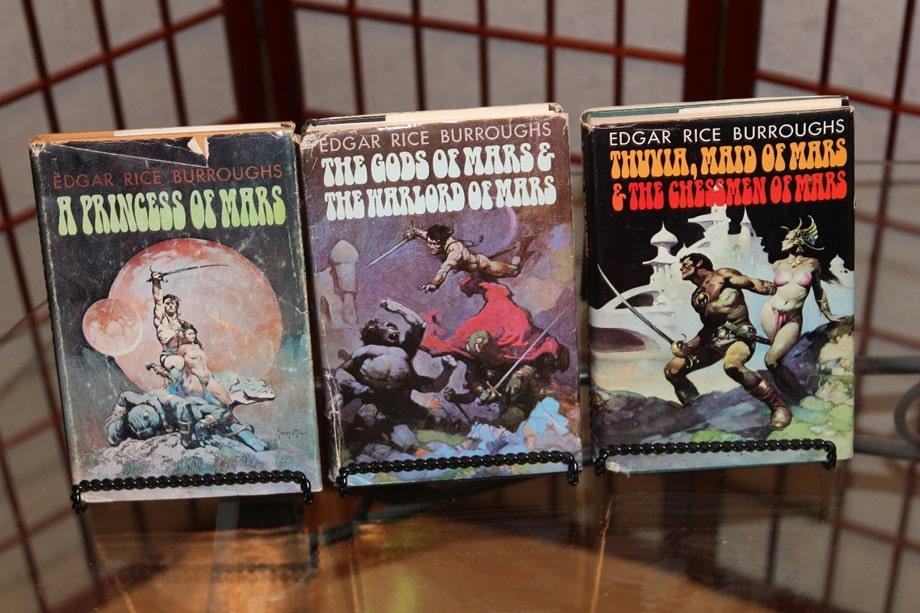 Edgar Rice Burroughs’ Barsoom novels: A Princess of Mars, The Gods of Mars and The Warlord of Mars, and Thuvia, Maid of Mars and The Chessmen of Mars (Science Fiction Books Club, July 1970, January 1971, and January 1973). Covers by Frank Frazetta
Edgar Rice Burroughs’ Barsoom novels: A Princess of Mars, The Gods of Mars and The Warlord of Mars, and Thuvia, Maid of Mars and The Chessmen of Mars (Science Fiction Books Club, July 1970, January 1971, and January 1973). Covers by Frank Frazetta
For sheer fun and adventure there’s nothing better in my opinion than Sword & Planet fiction (also called Interplanetary Adventure, Interplanetary Romance, or Planetary Romance). But exactly what is Sword & Planet fiction? Well, Edgar Rice Burroughs (ERB) created the prototype in 1911 with A Princess of Mars, which featured an Earthman named John Carter who is mysteriously transported to Mars, called Barsoom by its inhabitants.
The basic Sword & Planet story involves an earthman (rarely an earthwoman up to this point in time; 2025) on a strange world where he must use his wits, his muscles, and his sword against a host of human and nonhuman foes. The hero is generally chivalrous and the setting is an exotic alien world, often with multiple suns or multiple moons, populated by a variety of strange plants, animals, and intelligent beings. Magic is virtually non-existent, but there may be elements of “super-science,” such as open-decked flying ships or even ray-guns, although the latter take second billing to the blade. The emphasis is on swashbuckling sword fights, wild escapes, and desperate rescues.
[Click the images for Mars-sized versions.]
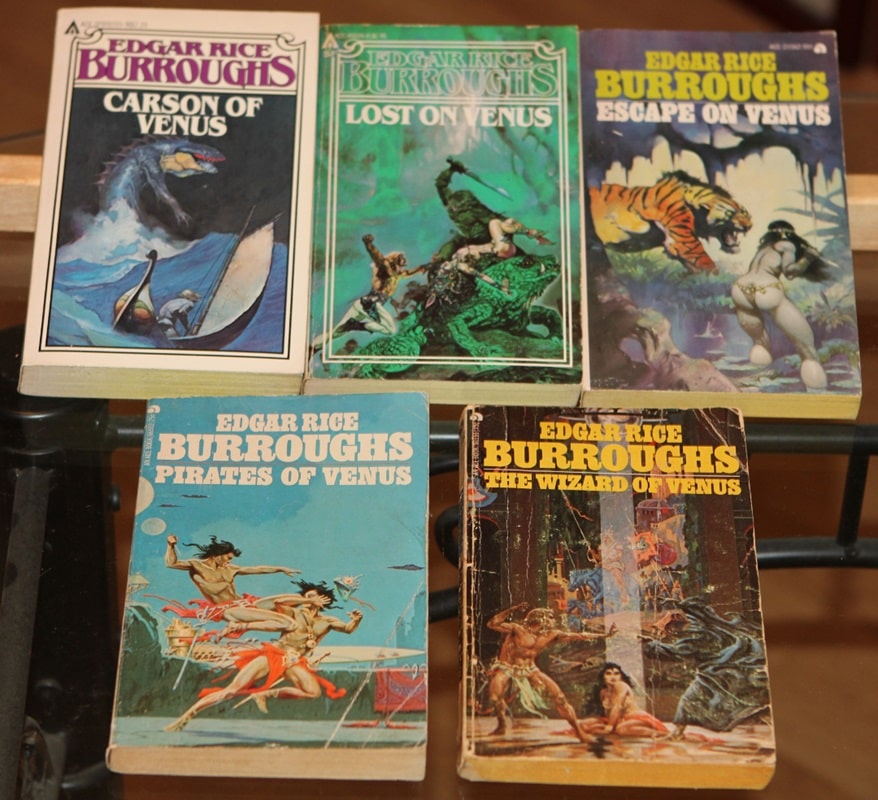 Edgar Rice Burroughs’ Venus novels: Carson of Venus, Lost on Venus, Escape on Venus, Pirates of Venus, and The Wizard of Venus (Ace Books, June 1979, June 1979, January 1974, March 1973, and January 1973). Covers by Frank Frazetta, Esteban Maroto, Frazetta, Roy G. Krenkel, and Roy G. Krenkel
Edgar Rice Burroughs’ Venus novels: Carson of Venus, Lost on Venus, Escape on Venus, Pirates of Venus, and The Wizard of Venus (Ace Books, June 1979, June 1979, January 1974, March 1973, and January 1973). Covers by Frank Frazetta, Esteban Maroto, Frazetta, Roy G. Krenkel, and Roy G. Krenkel
In addition to the Barsoom books, ERB also wrote a second Sword & Planet series, five books set on Venus (Amtor to the natives), featuring the earthman Carson Napier. Napier is intending to fly a rocket ship to Mars but ends up crashing on cloud-covered Venus.
He finds a world of giant trees and strange creatures, and, of course, a princess. Her name is Duare. Like Barsoom, Amtor mixes the primitive with super science, but the emphasis is on action, adventure, and personal combat with edged weapons.
 Escape on Venus, The Moon Men, Pirates of Venus, A Fighting Man of Mars, and The Chessmen of Mars (Ace Books, 1964, October 1962, January 1963, March 1963, and December 1962). Covers by Roy G. Krenkel, Ed Emshwiller, Krenkel, Krenkel, and Krenkel
Escape on Venus, The Moon Men, Pirates of Venus, A Fighting Man of Mars, and The Chessmen of Mars (Ace Books, 1964, October 1962, January 1963, March 1963, and December 1962). Covers by Roy G. Krenkel, Ed Emshwiller, Krenkel, Krenkel, and Krenkel
The five books in the series are:
1. Pirates of Venus
2. Lost on Venus
3. Carson of Venus
4. Escape on Venus
5. The Wizard of Venus
The Wizard of Venus is a novelette that wasn’t published until after ERB’s death. The book includes a second novelette called “Pirate Blood.”
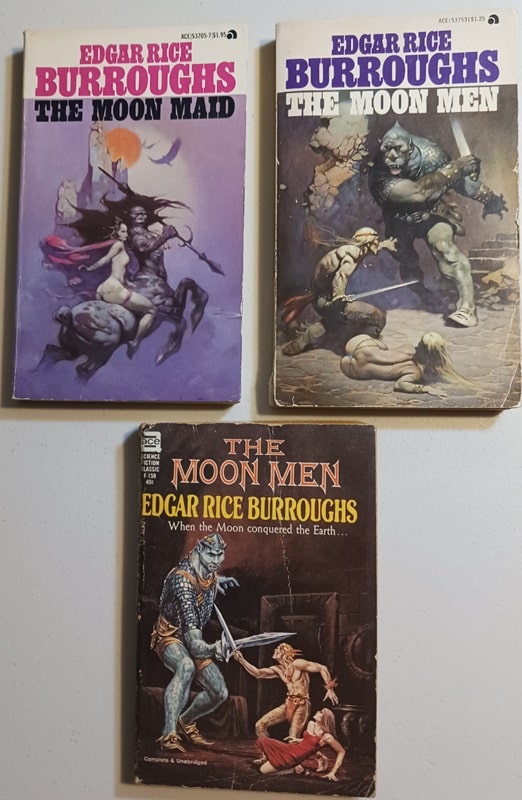 The Moon Maid, The Moon Men, and The Moon Men (Ace Books, January 1974, March 1974, and October 1962). Covers by Frank Frazetta, Frazetta, and Ed Emshwiller
The Moon Maid, The Moon Men, and The Moon Men (Ace Books, January 1974, March 1974, and October 1962). Covers by Frank Frazetta, Frazetta, and Ed Emshwiller
I enjoyed ERB’s Venus books a lot but they were not the equal of his Mars books — in my opinion. A lot of this has to do with Carson Napier. He’s no John Carter. He is a hero, and brave, but he makes plenty of mistakes and often needs to be rescued himself. He also uses more advanced weapons — essentially ray-guns — on many occasions. That means less “swashbuckling,” a minus for me. Certainly, though, if you’re interested in S&P fiction, the Venus books are a must.
The Venus books have been released in various editions. The pictures I have above mix older and newer editions. The older ERB books have covers and illustrations by Roy G. Krenkel, Jr, one of my favorite artists. Some of the newer ones have Frazetta images, and Frazetta was influenced by Krenkel.
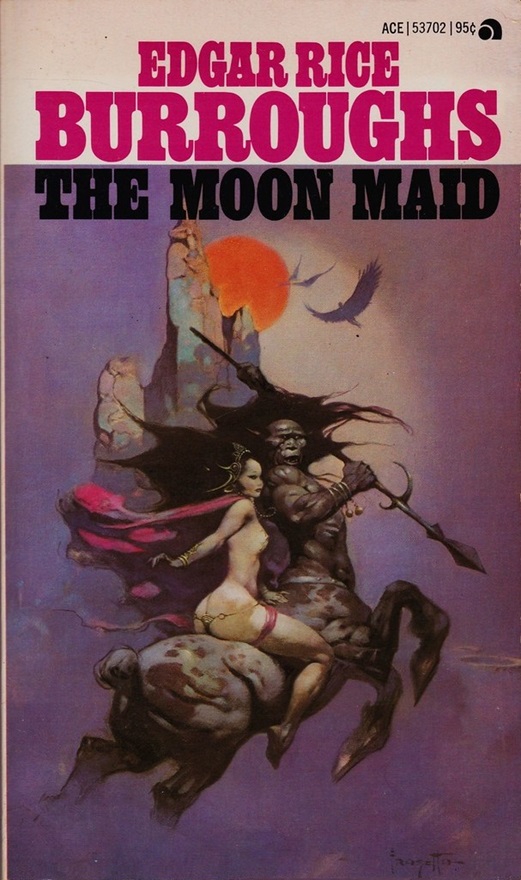 The Moon Maid (Ace Books, January 1974). Cover by Frank Frazetta
The Moon Maid (Ace Books, January 1974). Cover by Frank Frazetta
A series that I would have liked to see more of from ERB was his Moon Maid series. It’s sometimes described as a trilogy, but only the first book is full length. That’s The Moon Maid (copyright 1923). The sequels are novellas called The Moon Men and The Red Hawk (copyright 1925), which I first read combined in a later Ace book called The Moon Men. The novellas are reprinted from the pages of Argosy All-Story Weekly, where the tales were first serialized in 1925.
The Moon Maid has an awesome Frank Frazetta cover that is one of my favorites among his works. I have two copies of The Moon Men, one with a Frazetta cover and the other with a cover by Ed Emsh.
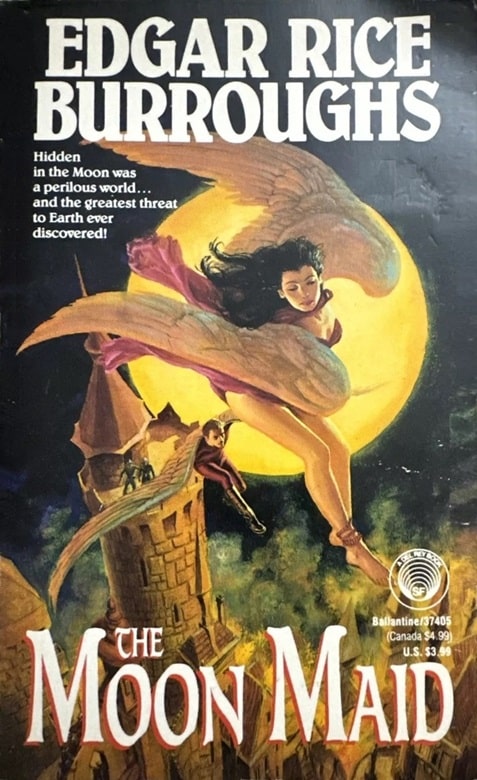
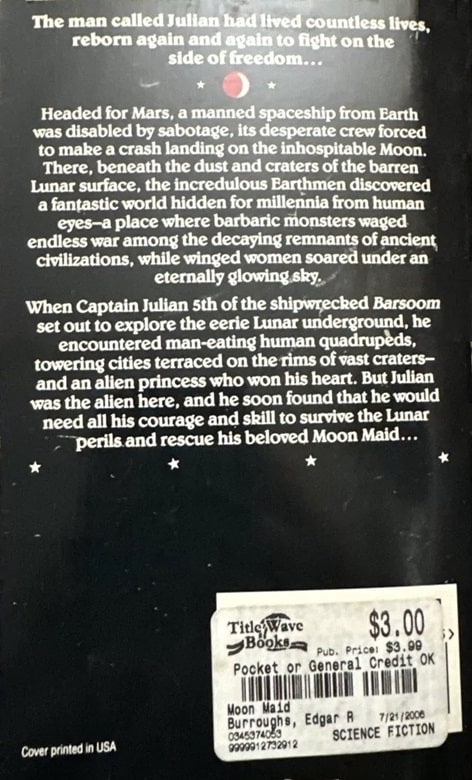
The Moon Maid (Del Rey Books, May 1992). Cover by Laurence Schwinger
The hero in The Moon Maid is Julian the 5th, an Earthman who has lived through many previous incarnations and remembers them. He is leading a rocket ship journey to Mars when the ship has to make a forced landing on the Moon.
They find an oxygen atmosphere inside the moon, and a wild land of strange creatures, including human-type and centaur-type intelligent races. Julian meets a princess of the human-type, Nah-ee-lah, and must rescue her. There’s lots of action and hand to hand combat, although not a lot of sword fighting. I would classify it as S&P.
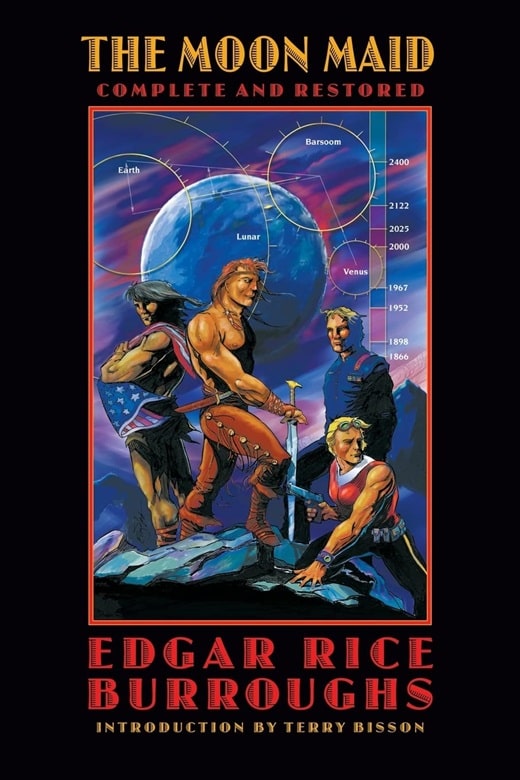
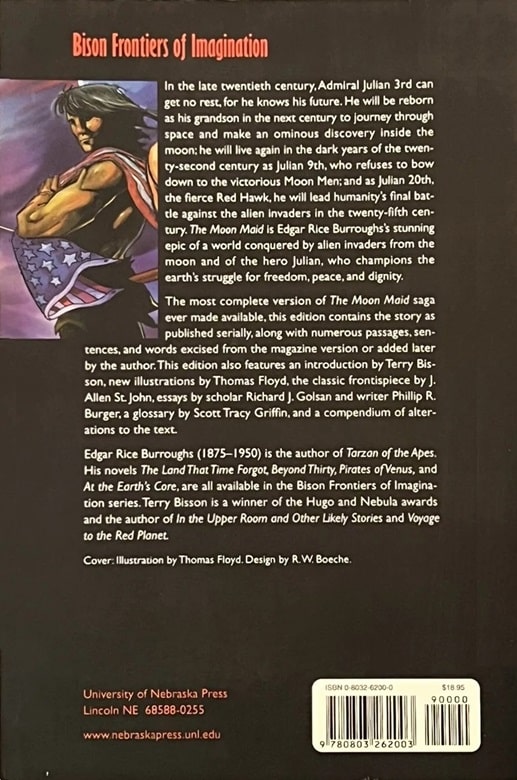
The Moon Maid: Complete and Restored (Bison Books, April 2002). Cover art by Thomas Floyd
The Moon Men and The Red Hawk are not — properly speaking — S&P fiction, because they take place on Earth. In The Moon Men, the Kalkar inhabitants of the Moon have conquered Earth. Julian the 9th, another reincarnation, leads a revolt, but it remains to “Red Hawk,” a descendent of Julian to finally free Earth from the Lunarians’ rule.
The three parts of the Moon trilogy have been published together by Bison books along with all kinds of extras (see above). I don’t have that copy yet but will get it for my collection. The series is one of ERB’s best.
More on Burroughs, including Tarzan and The Land that Time Forgot, in my next post.
Charles Gramlich administers The Swords & Planet League group on Facebook, where this post first appeared. His last article for Black Gate was The Masters of Narrative Drive.
Spotlight on “Victorian Psycho” by Virginia Feito
Victorian Psycho is soon to be a feature film from A24 starring Margaret Qualley and…
The post Spotlight on “Victorian Psycho” by Virginia Feito appeared first on LitStack.
On McPig's Radar - Never the Roses
Did I already read this? Yes!
Am I still totally looking forward to getting this beauty in my eager trotters? YES!
Believe me: you want this book! It's utterly amazing and beautiful in and out!
Go preorder: I totally did.
 Never the Rosesby Jennifer K. Lambert
Never the Rosesby Jennifer K. LambertUNSTOPPABLE WAR. UNSPEAKABLE SINS. IMPOSSIBLE LOVE.
Genevieve Gornichec’s The Witch’s Heart meets Madeline Miller’s Circe in this epic and deeply emotional romantic fantasy debut by Jennifer K. Lambert. The hardcover edition features beautiful stenciled edges.
The Dread Sorceress Oneira has retired. She’s exhausted from fighting the endless wars of kings and queens, and has long accepted that her death is near. Alone at last but for a few uninvited companions―a near-mythical wolf, a goddess’s avatar, and a feline that embodies magic itself―Oneira realizes that she’s bored. On a whim, or perhaps at the behest of fate, she makes an unlikely trip to the most extensive library in existence: the home of her most powerful rival, the sorcerer Stearanos.
By recklessly stealing a book from him, Oneira inadvertently initiates a forbidden correspondence. Taunting notes and clever retorts reveal a connection neither has found―nor could ever find―in any other.
But Oneira soon learns that Stearanos, bound to a vile king, is tasked with waging war on the queen she once served. A relationship with him is far too dangerous to pursue despite their mutual desire―and yet, Oneira can’t seem to stay away.
A bond with Stearanos could alight the long-extinct flame of life within her… or it could destroy her entirely.
Expected publication July 8, 2025
Review: Grave Empire by Richard Swan

Buy Grave Empire OFFICIAL AUTHOR BIO: Richard Swan is a critically acclaimed British genre writer. His debut fantasy novel, The Justice of Kings, was an instant Sunday Times bestseller and has been translated into seven languages. His other work includes the Art of War and Great Silence trilogies, as well as short fiction for Black Library and Grimdark Magazine.
Richard is a qualified lawyer, and before writing full time spent ten years litigating multimillion pound commercial disputes in London. He currently lives in Sydney with his wife and three young sons.
FORMAT/INFO: Grave Empire will release on February 4th, 2025. It will be available in paperback, ebook, and audiobook formats.
OVERVIEW/ANALYSIS: Renata Rainer's job is a joke. As ambassador to the Stygion mermen, she largely has given up hope of ever being useful, given that the mermen want nothing to do with humans. But when two monks arrive claiming to have lost contact with the afterlife, suddenly Renata finds herself in the midst of a critical mission. The Stygion are some of the world's foremost arcana practitioners, and it's up to Renata to verify if recent portents do indeed herald an apocalyptic event known as the Great Silence. But Renata's not the only one interested in the Great Silence - and there are those who want help along the end of the world instead of stopping it.
Grave Empire is a haunting, harrowing journey that envelopes you in its atmosphere, while asking readers for patience in experiencing the actual payoff. This is a story of three individuals scattered across an empire who are realizing that a Very Bad Thing is coming. One is unraveling the secrets of a mysterious plague, another must travel through a warzone to consult with magic practitioners who can shed light on an ancient prophecy, and another is investigating strange reports on the frontier of the empire. Each story is compelling and unsettling, as our characters come to understand just how very wrong things are.
And yet when the dust settled, it felt like all that had been accomplished was learning that yes, a Bad Thing is coming and it is a VERY Bad Thing. The nature of the Great Silence is absolutely a satisfactory threat, and I look forward to seeing how our characters try to handle it, especially as some dominoes began tipping at the end of our story. But this first book is essentially all table setting. Here is the empire, here are the characters, here is the state of the mortal plane, here are some of the weird things that are happening. Will we explain how these weird things are tied together? Not really.
I do want to touch on the relationship between the Empire of the Wolf trilogy and this new The Great Silence trilogy. You do not need to have read the first trilogy to enjoy this new series; the events of Empire of the Wolf are as removed from the characters as the Napoleonic Wars are for us. Those events were definitely a big thing that happened, but they don't inform the characters' day to day lives.
The writing here is also more accessible than the previous trilogy. The first series was told first-person memoir style, while this new one is told across three third-person POVs. I think it also reflects the difference in tone between the two stories. Whereas Empire of the Wolf was a more personal journey of an individual caught up in world-shaking events, Grave Empire feels a little more big picture, a view of how several nations will grapple with a new threat.
CONCLUSION: I want to be clear, overall I really enjoyed Grave Empire, even if the ending left me a bit underwhelmed. I remain hopeful that the second book in this trilogy is going to take everything in the first book and use it for a fantastic sequel. In reading the first trilogy set in this world, I was lukewarm on book one, and then the sequel was one of my top reads the following year. Given how monumentally unsettling the nature of the Great Silence is, I think there's every chance this series will follow in its predecessor's footsteps.
Howard Andrew Jones, a Mentee’s Perspective
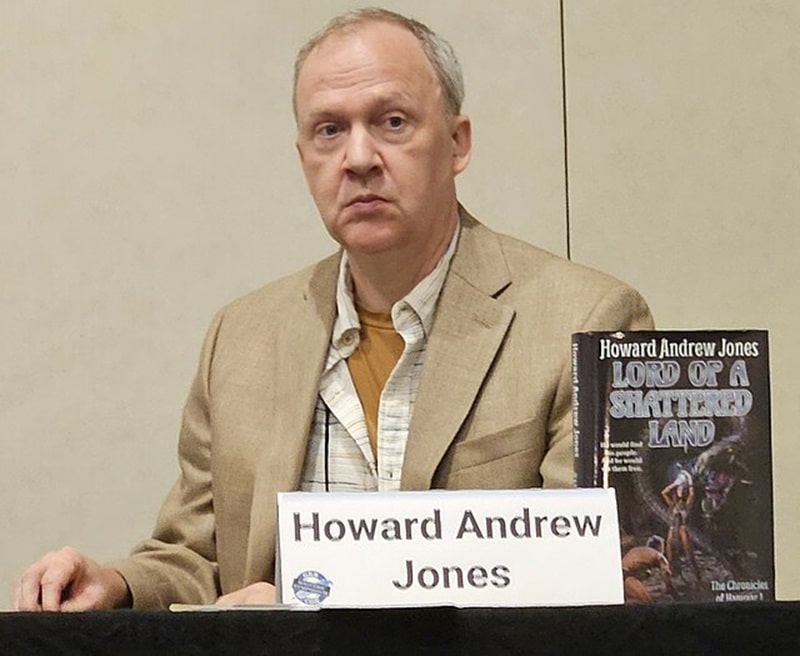 Howard Andrew Jones at GenCon, 2023
Howard Andrew Jones at GenCon, 2023
In 2019, I had an idea: a lot of my friends loved reading sword and sorcery fiction, but they didn’t write it. They would say, “One day.” Many of my undergraduates also expressed interest in writing fantasy, but they often felt discouraged by form rejection letters (genre magazine slush piles are epic). Having studied the history of genre fiction, I knew about the old tradition of “fanzines”— not-for-profit amateur publications that provided a low-stakes outlet for new writers. Just submitting work, collaborating with an editor, and seeing it in print can transform someone’s self-image from being just a reader to being a writer.
So, after some conversations with friends and a bit of encouragement, I started thinking seriously about launching my own zine.
As an academic, I’m deliberate by nature. I like to consult and take my time. Honestly, if I could have formed a committee for this, I probably would have. Instead, I decided to email someone: Howard Andrew Jones.
[Click the images for larger versions.]
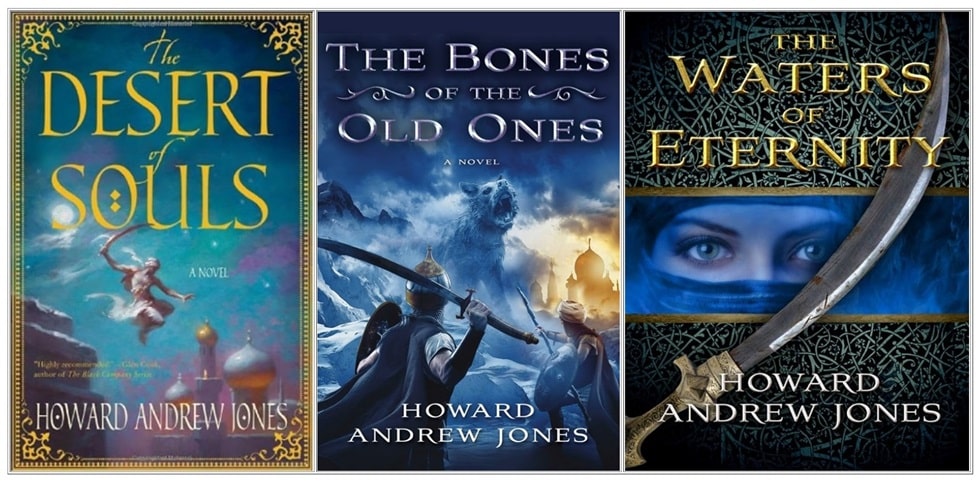 The three Dabir and Asim volumes: The Desert of Souls, The Bones of the Old Ones, and the collection The Waters of Eternity (Thomas Dunne Books, February 2011, December 2012, and November 2011). Covers by Charles Keegan, Steve Stone, uncredited
The three Dabir and Asim volumes: The Desert of Souls, The Bones of the Old Ones, and the collection The Waters of Eternity (Thomas Dunne Books, February 2011, December 2012, and November 2011). Covers by Charles Keegan, Steve Stone, uncredited
At the time, I didn’t know Howard personally, but I knew of him. He was a celebrated name in sword and sorcery. Howard had published an e-zine (Flashing Swords) in the genre, written essays and edited for Black Gate, and authored an incredible series of novels set in a sword-and-sorcery-inspired Arabia featuring Dabir and Asim (The Desert of Souls and The Bones of the Old Ones). He was also working on a new trilogy, The Ring-Sworn Trilogy, and I had already read the first book.
On top of all that, Howard had written several fun Pathfinder RPG novels, and he was editing Tales from the Magician’s Skull, the magazine for contemporary sword and sorcery fiction, published by Goodman Games. I loved that magazine. If anyone could give me advice on starting a zine, it was Howard.
I didn’t expect much when I emailed him. I wrote a long message, gushed a bit as a fanboy, and sent it off. Honestly, I wasn’t really expecting a response.
The next day, I was in my campus office grading papers when my office phone rang. My office phone never rings. In my ten years at CNU, maybe one student has ever called me. It’s practically an artifact – a dusty relic of a bygone era. My first instinct, as a millennial, was to let it go to voicemail. That’s what you do: let them leave a message and call back after some breathing exercises.
But for some reason, I picked it up.
“Hello?”
“Jason?”
“Yeah, this is Jason.”
The voice on the other end was calm, relaxed, with a kind of deliberate enunciation.
“Heeey, Jason! This is Howard.”
“Howard?” I said, not quite connecting the dots.
“Howard Andrew Jones. You emailed me about a magazine idea.”
I still get a little emotional thinking about that first call. Maybe I’m projecting, but I was immediately surprised, disarmed, and touched. Howard had gone out of his way to call me – call me! My office number isn’t even in my email signature, so he must have looked me up online to find my CNU contact info. I hadn’t even expected a reply, and here was this great author, taking the time to phone me.
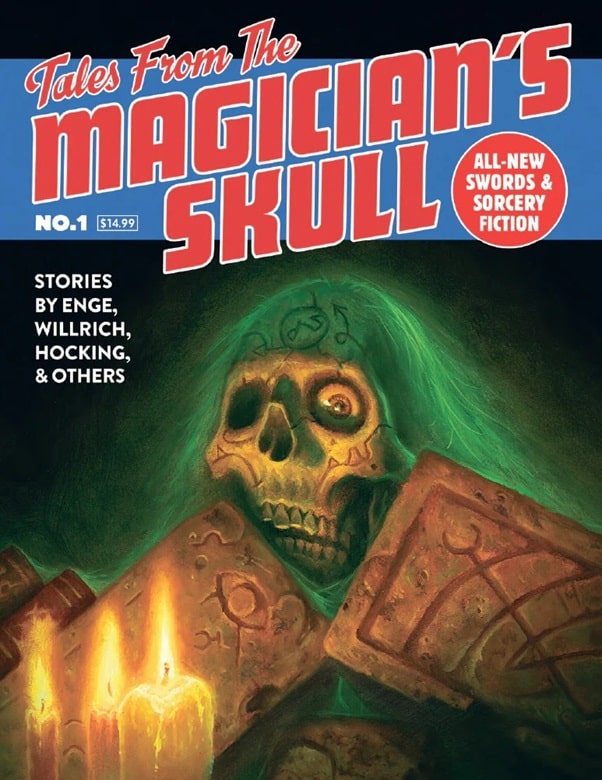
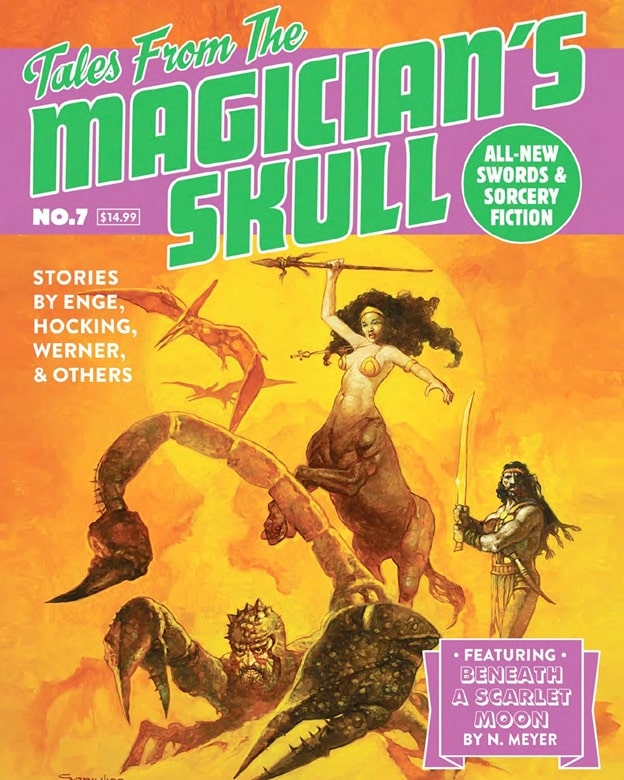
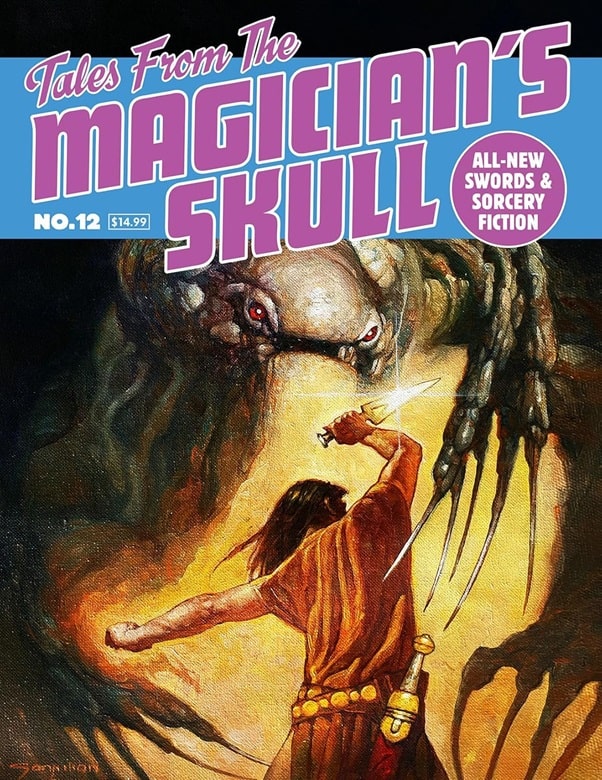
Tales of the Magician’s Skull, edited by Howard Andrew Jones. Issues 1, 7, and 12
(Goodman Games, 2017, 2022, and 2024). Cover art by Jim Pavelec and Sanjulian
I was a bit starstruck when we first talked. I’m already an awkward person, but the awkwardness was dialed up as I tried to gather my bearings. Howard, however, was so kind, calm, and genuinely enthusiastic about fiction, writing, and fantasy literature that I found myself speaking to him like an old friend. I’m pretty sure we talked for over an hour during that first conversation. I remember he was multitasking while on the phone – taking out the trash or doing yard work.
In the years that followed, whenever I spoke to Howard, he always seemed to be en route somewhere – driving to town, running errands, sometimes saying, “Hold on, I’ve got to grab this thing.” He felt real and grounded in a way that made people feel at ease. He gave off this sense of being completely unaware of how cool he was or how others saw him – or, if he did know, he just didn’t put much stock in it.
Over the next five years, Howard and I stayed in almost constant contact. We texted regularly. Often, he’d reply to a message with something like, “You free? Driving to town.” When I started my magazine and created an associated Discord server, he joined and became as active there as anyone, if not more so.
His comments were always supportive, kind, and encouraging. He shared favorite authors, thoughts on prose style, and a steady drip of wisdom for aspiring writers. Whenever anyone mentioned his work, he would chime in, “Thanks for reading it,” “Glad it worked for you,” “Really appreciate the kind words.”
Outside of Discord, we talked on the phone often. One thing I noticed was that Howard frequently mentioned his friends – not in a name-dropping way, like he wanted you to know he knew big authors, but in a way that made you feel like you were part of this collaborative effort, this network of fellow creatives. To him, it seemed, writing wasn’t a solitary pursuit but a shared craft. It was like Howard was always attending a seminar on fiction, and his calls were a way of touching base to see how your progress was going.
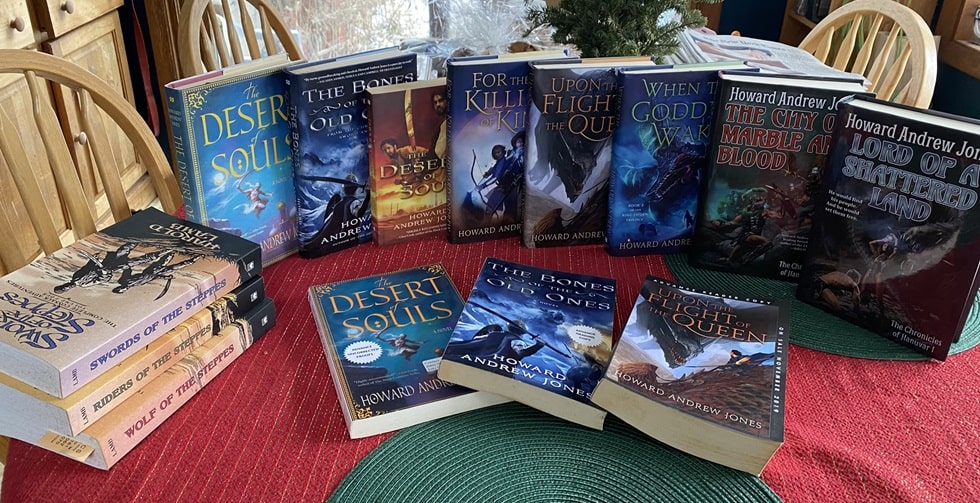 The books of Howard Andrew Jones
The books of Howard Andrew Jones
For instance, he’d say something like, “Hocking and I were talking about dialogue – how it needs to reveal character but economically, like in hardboiled detective fiction” (I’m paraphrasing). From the way he spoke, I got the sense that Howard had a lot of writer friends, and they talked about the craft of writing the way master carpenters might talk about solving technical problems with wood.
Fandom can get a little gossipy, but Howard never said a negative thing about anyone. He was almost stubbornly kind and assumed the best intentions from people. Being in touch with him felt like being welcomed into a very supportive club. Over time – without me even realizing it – Howard became something of a mentor or even a sensei in sword and sorcery writing.
At first, we just talked about sword and sorcery (a genre he was deeply opinionated about – he really didn’t like Tros of Samothrace (“Bounced right off it)), but our discussions evolved into broader topics: writing, work, heroism, and how storytelling affects people’s lives. I can honestly say I learned a lot about writing from him, at least an MFA’s worth, or more.
I met Howard in person three times over the six years I knew him. I saw him at GenCon, the big gaming convention that also includes a section for genre writers. We sat on several panels together discussing sword and sorcery fiction. He attended Howard Days, a celebration of Robert E. Howard, the pulp author who created sword and sorcery (yes, it gets confusing). And then I saw him again at GenCon this past August of 2024.
In August, aside from a persistent leg injury, Howard seemed… OK. I need to be honest and say he struck me as a little blue at GenCon, and he suspected it was due to the injury or the associated medication treating it. He had every reason to be happy. He had just published the first two books of his Hanuvar series. If I remember correctly, book three, Shadow of the Smoking Mountain, had just come out or was coming out. At the convention, he gave me an ARC and signed it with the words, “Find a way or make one.” I took this as a nod to the writer’s life, a reminder to persevere and create despite the challenges.
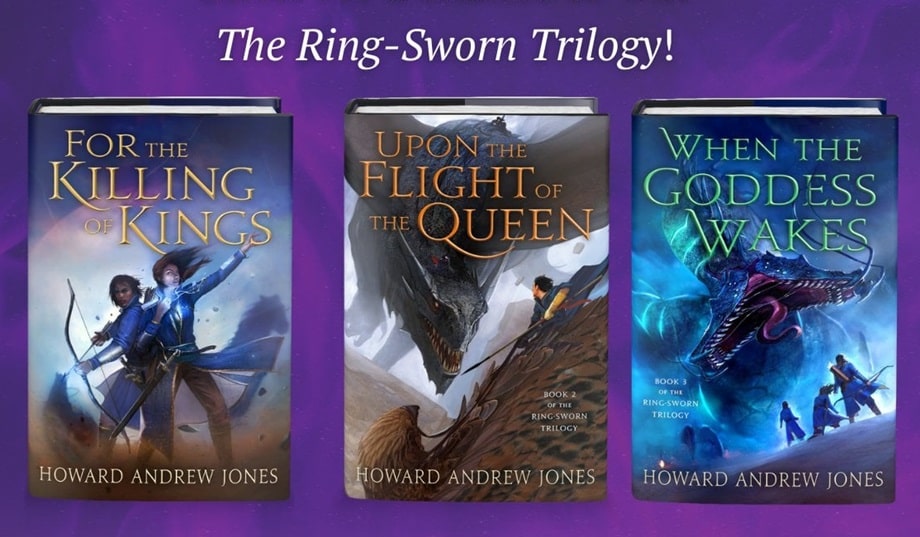 The Ring-Sworn Trilogy by Howard Andrew Jones (St. Martin’s Press, 2018-2021). Covers by Lauren Saint-Onge
The Ring-Sworn Trilogy by Howard Andrew Jones (St. Martin’s Press, 2018-2021). Covers by Lauren Saint-Onge
On the last day of GenCon, literally just before leaving, Howard, my wife Nicole, and I had lunch together. It was the first time Howard had met Nicole. She joked and referred to Howard as “my friend in my pocket” because I was always texting with him. I laughed and told her, “You don’t understand – this guy is so cool. He’s the nicest guy you’ll ever meet.”
That might sound like grief-motivated hyperbole now, but, in hindsight, it wasn’t. That’s exactly how I spoke about Howard before I knew anything was wrong.
Nicole and I had lunch with him, and of course, they hit it off. I can’t recall the details but Howard was fascinated with Nicole’s life growing up on a farm (did Howard come from a rural background?). After the meal, Howard said he was glad to have met her.
We left the restaurant. There were hundreds of people in the corridors at GenCon, a veritable sea of humanity, and Nicole and I were ready to leave, luggage in hand. So, we said our goodbyes. I had no idea it was the final goodbye. Howard gave me a hug and said, “Well, safe travels to you and your beautiful wife. And, keep writing.” Then he disappeared into the crowd.
A few weeks later, I learned he had gone to the hospital with acute symptoms.
I’m still in the anger phase of all this. Howard was such a good guy. It felt like, as a writer, he was hitting his peak. In my view, he had so much more to give the world – not just through his novels but through who he was as a person. I know my story is just one of many similar ones. That’s the kind of person Howard was: everyone who met him seemed to come away with a story about his kindness. This tragedy couldn’t have happened to a more undeserving person.
Howard, you’ll be missed, man. Thanks for being you.
Jason Ray Carney is a Lecturer in Popular Literature at Christopher Newport University. He is the author of the academic book, Weird Tales of Modernity (McFarland), and the fantasy anthology, Rakefire and Other Stories (Pulp Hero Press). He edited Savage Scrolls: Thrilling Tales of Sword and Sorcery for Pulp Hero Press and is an editor at The Dark Man: Journal of Robert E. Howard and Pulp Studies and Whetstone: Amateur Magazine of Sword and Sorcery. His last article for Black Gate was a review of Lord of a Shattered Land.
7 Author Shoutouts | Authors We Love To Recommend
Here are 7 Author Shoutouts for this week. Find your favorite author or discover an…
The post 7 Author Shoutouts | Authors We Love To Recommend appeared first on LitStack.
Graphic novel: Final Cut by Charles Burns

Book links: Amazon, Goodreads
ABOUT THE AUTHOR: Charles Burns grew up in Seattle in the 1970s. His work rose to prominence in Art Spiegelman's Raw magazine in the mid-1980s and took off from there, for an extraordinary range of comics and projects, from Iggy Pop album covers to the latest ad campaign for Altoids. In 1992 he designed the sets for Mark Morris's delightful restaging of The Nutcracker. He's illustrated covers for Time, the New Yorker and the New York Times Sunday Magazine. He is the official cover artist for The Believer magazine. Black Hole received Eisner, Harvey and Ignatz awards in 2005. Burns lives in Philadelphia with his wife and two daughters.
Publisher: Pantheon (September 24, 2024) Length: 224 pages Formats: Hardcover, ebook
It’s been a long wait -ten years, to be exact-but Charles Burns is back with Final Cut, a weird, sad, and beautifully drawn trip into the mind of an awkward teenage filmmaker named Brian. Set in the early ‘70s, the story follows Brian as he and his friends make a low-budget horror movie on a camping trip.

Everything revolves around Laurie, Brian’s red-haired crush, who becomes his muse, his obsession, and, ultimately, the centerpiece of a story he might be rewriting in his head.

As a result, Final Cut can initially feel like a simple coming-of-age story about a group of friends making a low-budget film in the woods. But true to Burns’ style, there’s so much more beneath the surface. As Brian edits his movie, it becomes clear he’s also “editing” his memories of that summer, creating a version of events where he has more control—and maybe even the happy ending he never got.
This comic has great vibes. You’ve got razor-sharp art that’s stunning, a creeping sense of unease, and characters you’re not quite sure how to feel about. Since I love unreliable narration, I loved the eerie, dreamlike atmosphere. Brian’s a loner who’s into art and movies—cool enough—but he’s also kinda creepy. He films Laurie without her knowing, sketches naked pictures of her, and lurks outside her tent at night. His version of events might not be a full story.

That’s the hook here: is this all really how it went down, or is Brian “editing” the summer in his head to make it more palatable? He’s a filmmaker, after all, and Final Cut plays with that idea of memory as a movie you can tweak. The whole thing has this dreamy, slightly unsettling vibe, like you’re stuck in Brian’s head with him.
The art? Absolutely stunning and otherworldly. Burns’ haunting artwork is unparalleled, as he effortlessly shifts between grounded realism and surreal horror. The color palette—rich blues, stark whites, and deep reds—heightens the unsettling atmosphere, while the splash pages and film-like sequences are nothing short of stunning.

If there’s a downside, it’s that the pacing can be uneven and its core is quite simple, really. Unrequited teenage love, even with all the surreal touches, might not sound like much on paper. And yeah, some parts drag, like the repetitive “making the movie” scenes. But by the end, Final Cutk hits you with this quiet, bittersweet sadness.
Final Cut is a beautifully weird, unsettling, and surprisingly tender look at love, art, and the stories we tell ourselves. If you’re a fan of Charles Burns or just love weird, thoughtful comics, this one’s worth the ride.
Book Review: At the Bottom of the Garden by Camilla Bruce
I received a review copy from the publisher. This does not affect the contents of my review and all opinions are my own.
 At the Bottom of the Garden by Camilla Bruce
At the Bottom of the Garden by Camilla Bruce
Mogsy’s Rating: 3.5 of 5 stars
Genre: Horror
Series: Stand Alone
Publisher: Del Rey (January 28, 2024)
Length: 384 pages
Author Information: Website | Twitter
I’ve been a fan of Camilla Bruce ever since I read You Let Me In, which won over with its dark, complex characters and unsettling themes. Her stories so often blur the lines between the real and the supernatural, and her newest novel At the Bottom of the Garden seemed like it would too—a blend of eeriness and whimsy and atmosphere. However, certain aspects also fell short of my admittedly high expectations.
The book introduces Clara Woods, a conniving woman who seizes on an opportunity to reshape her future when a tragic climbing accident claims the lives of her brother and his wife, leaving her as the sole guardian of their two orphaned daughters. Ambitious and cunning, Clara dreams of becoming the head of her own diamond business but lacks the funds to make it happen. With her late brother’s estate now in the hands of his children, Clara begins to plot her way into gaining access to their inheritance.
Still grieving the loss of their parents, 14-year-old Lily and 9-year-old Violet suddenly find themselves transported from their lavish townhome into a decaying manor in the countryside, living with their aunt whom they hardly know. Clara seems kind enough, and says all the right things, but the girls know better. Each secretly harbors a unique gift—Lily can “see” the emotions of others as different colors, while Violet has an inexplicable connection to the realm of the unliving. As their aunt’s manipulative behavior grows worse, the sisters begin to suspect her motives, especially when the house begins to feel increasingly suffocating and oppressive. One day, Violet’s mysterious ability unleashes a long-buried secret, and before long, Clara is surrounded by the ghosts of her past. A tense battle of wills ensues as Clara isn’t about to back down, while the girls grow increasingly defiant and emboldened by their powers.
The story primarily unfolds through chapters alternating between the perspectives of the three characters. Clara is a real piece of work—a greedy, social-climbing widow who is secretly delighted when her half-brother dies and only sees taking care of his daughters as a means to an end. Lily is more mature than her age would suggest, quietly observant and deeply protective of her younger sister. Violet is pure innocence, wanting only to please. Each POV adds a layer to this precarious dynamic, as the girls’ resistance causes Clara to push to take her scheming to the next level.
The writing style is interesting in this one, though it also strongly reminded me of In the Garden of Spite and All the Blood We Share, both books in which Camilla Bruce takes readers into the twisted minds of morally complex, often villainous characters. The main difference is, At the Bottom of the Garden takes on a more whimsical, cartoonish tone— turning Clara into something like a wicked witch from a children’s fairy tale. However, the charm doesn’t last. Eventually, the lack of depth shows through. You start wondering why the girls aren’t taking the obvious, logical steps to get out of their situation. Clara’s ideas become more and more far-fetched. Over time, these unrealistic elements just keep piling up, making the story feel increasingly oversimplified and shallow.
And though I ultimately liked that this was a ghost story, I couldn’t help but feel its potential was wasted. Things started out strong, with a sense of foreboding that was practically palpable. Yet as events unfolded, the plot began to lose its focus, meandering into subplots that distracted from the central conflict involving the haunting, the girls’ abilities, and Clara’s role as a murderess. All that started to feel like a backdrop rather than the key driving force, and by the time we got to the ending, the resolution was rushed and somewhat unsatisfying. The ending simply lacked the emotional impact I was hoping for, a letdown after the tensions built throughout the story.
Overall, in my opinion, At the Bottom of the Garden was not Camilla Bruce’s best, but the strange gothic dark fairy tale vibe does make it more unique and stand out among her other books. And despite my criticisms, I did enjoy it for its atmosphere and slow-burn supernatural plot. Recommended if you are a fan of the author, or for readers who can appreciate a lighter take on horror.
![]()
![]()
Teaser Tuesdays - Wizard of the Pigeons
This is a reread. First time reading it has to be between 2001 and 2009 somewhere. I borrowed it and now finally have my own copy.I mostly remember atmosphere, vibes, and that I loved it. Starts out promising, the writing is so good!

He swallowed queasily. The footlocker seemed to swell to fill his room, muttering its ugly secrets to itself.
(page 35, Wizard of the Pigeons by Megan Lindholm/Robin Hobb)
---------
Teaser Tuesdays is a weekly bookish meme, previously hosted by MizB of Should Be Reading. Anyone can play along! Just do the following: - Grab your current read - Open to a random page - Share two (2) “teaser” sentences from somewhere on that page BE CAREFUL NOT TO INCLUDE SPOILERS! (make sure that what you share doesn’t give too much away! You don’t want to ruin the book for others!) - Share the title & author, too, so that other TT participants can add the book to their TBR Lists if they like your teasers!
Savage Sword of Conan is Back
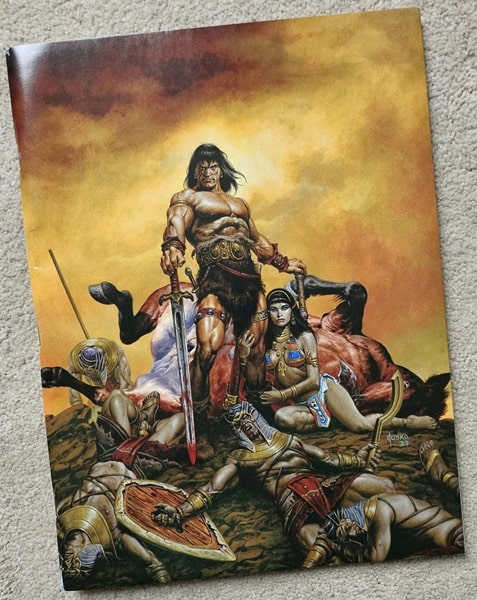
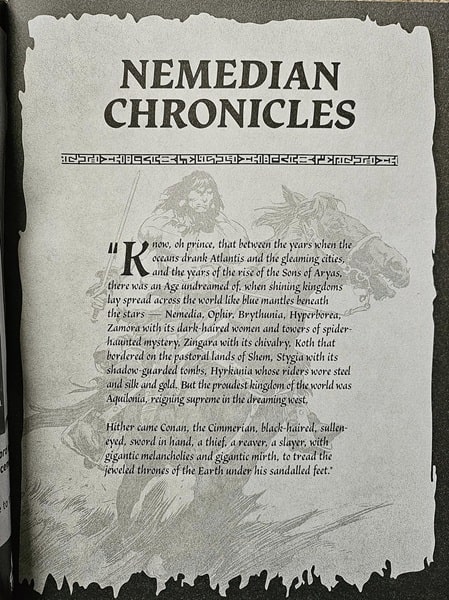
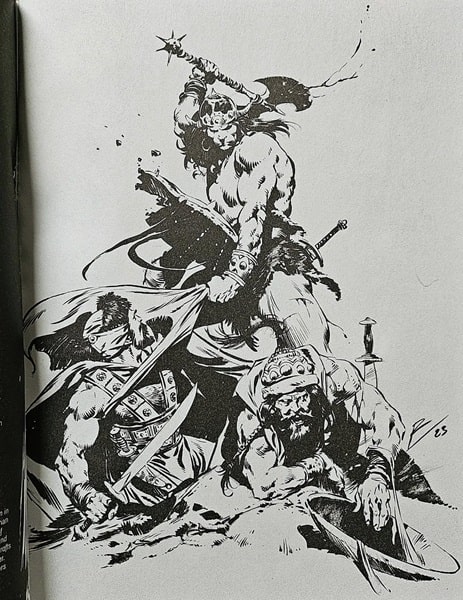
Savage Sword of Conan #1 (Titan Comics, February 2024). Cover art by Joe Jusko
Savage Sword of Conan, from Titan Comics, is the comic book that I have been waiting for. It is a thing of perfection: art, story, presentation, physical format – all unmatched.
The cover by Joe Jusko is brilliant, capturing some brutal imagery from the prose story within, penned by Jim Zub. I loved Joe’s work on the original SSoC run.
The introduction by Roy Thomas was a delight. Roy was the mastermind behind Conan the Barbarian and Savage Sword of Conan, but he’s also known for creating characters such as Wolverine, Vision, Werewolf by Night, Luke Cage, Iron Fist, Ultron, and scores more. Hearing that he had plans to contribute to this magazine filled me with joy.
[Click the images for savage-sized versions.]
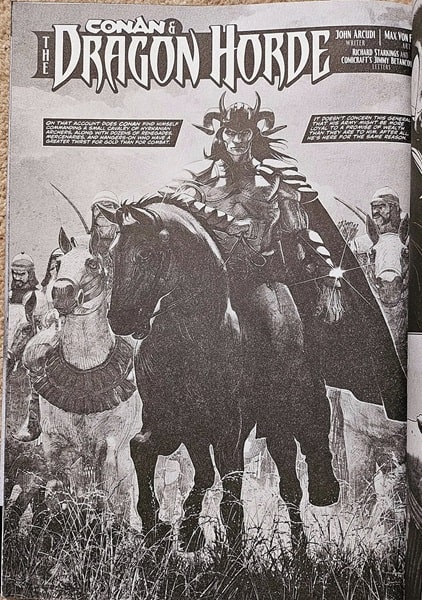
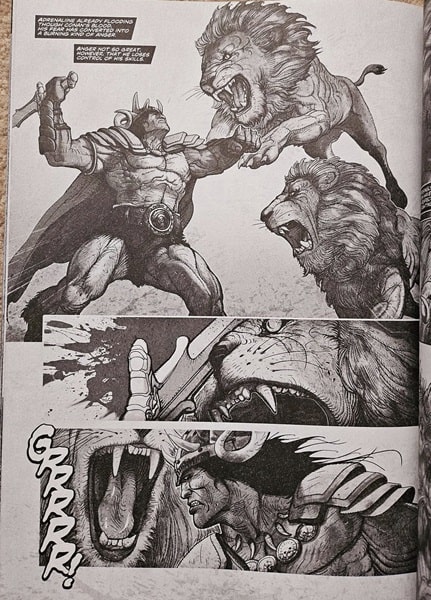
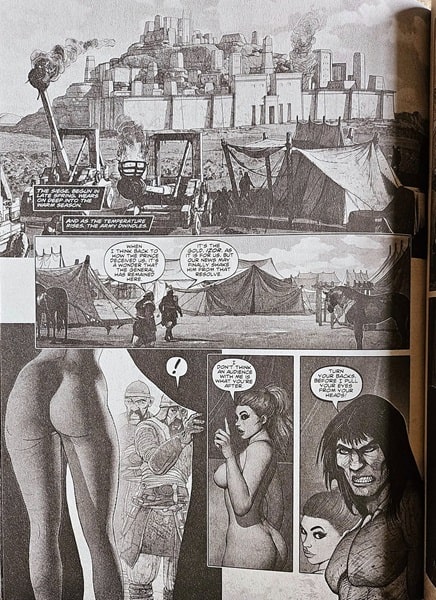
Interior pages from Savage Sword of Conan #1. Art by Max Von Fafner
The first story in SSoC #1 is called “Conan and the Dragon Horde,” written by John Arcudi, with art by Max Von Fafner. It has violence, bloodshed, nudity, sex, murder, betrayal, greed, superstition, intrigue, and horror. It is a classic Conan yarn that includes a fascinating female protagonist. Maybe she’ll stick around, or maybe she’ll go her own way, like Valeria. I can’t wait to see.
The prose story by Jim Zub, “Sacrifice in the Sand,” was a pleasant surprise. I have to admit to almost always feeling a sense of dread when someone other than REH writes Conan, but by Crom, this Zub guy gets it, much like his contemporary, John C. Hocking. The story was short, but the action was intense, realistic, and engaging, with a nice little twist at the end. Congrats, JZ.
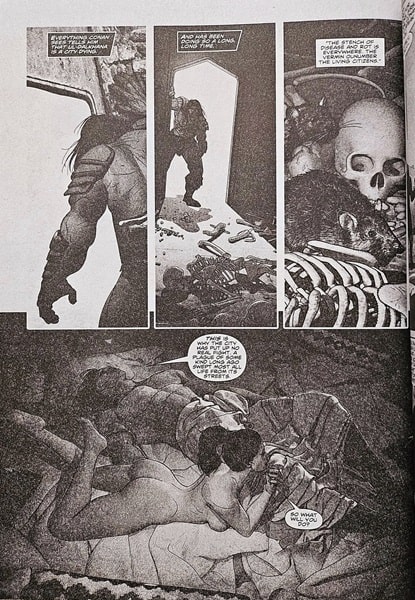
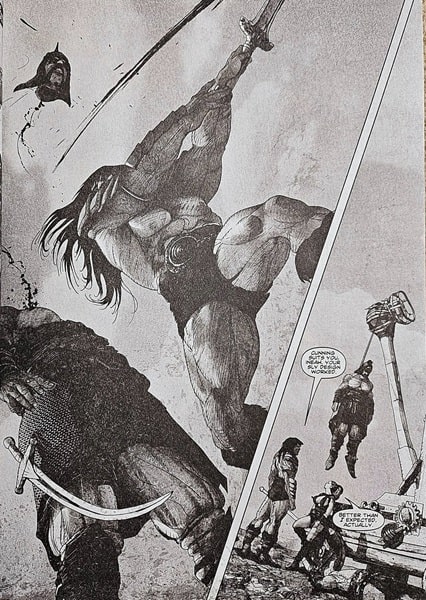
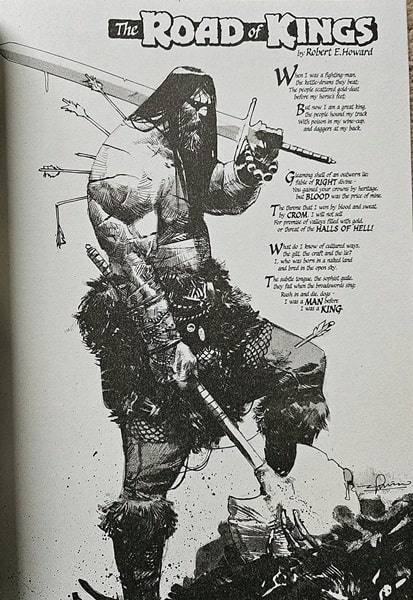
More interiors from Savage Sword of Conan #1. Art by Max Von Fafner
Next, we had a Solomon Kane yarn, “Master of the Hunt.” Placing an SK backup story in SSoC is chef’s kiss perfect. It brings back wonderful memories. Written and illustrated by Patrick Zircher, this was an excellent Gothic tale, with all that 1600s mood and tone. The Puritan gun-toting swashbuckler is one of REH’s finest creations, and he is well represented here.
The magazine closes with a piece by Jeffrey Shanks, who delves into the publishing history of Solomon Kane, which many readers will no doubt find fascinating. Jeff is a bona-fide REH scholar, much like my dog brothers, Mark Finn and Chris Gruber.
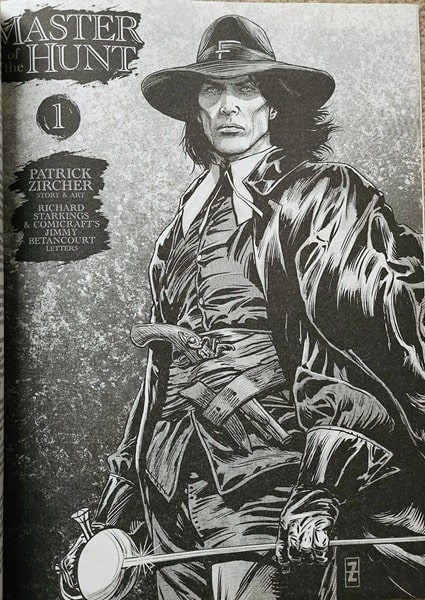
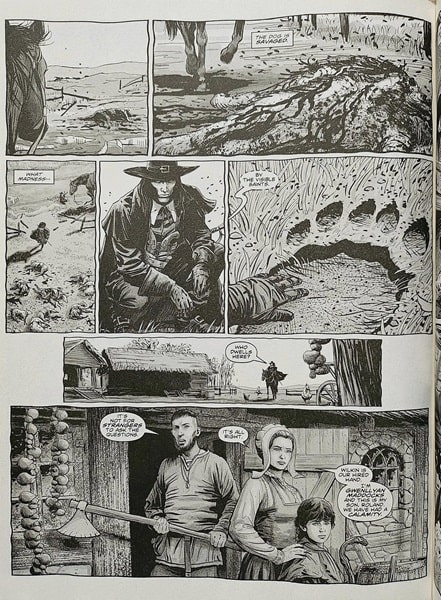
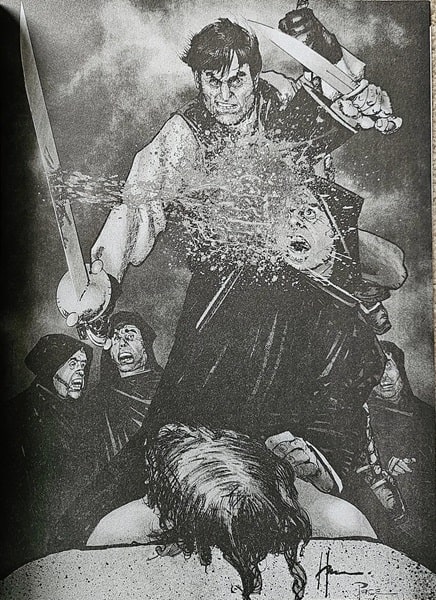
Interiors from Savage Sword of Conan #1. Art by Patrick Zircher and Howard Chaykin
This book was great. The husky offset paper is thick and opaque, yet has that newspaper quality to it, bringing back the nostalgia of the original run. You can smell the ink – it’s glorious.
One thing I would love to see in the future (and I know this is wishful thinking) is art by Val Semeiks in the pages of this series. I’ve been working with Val off and on for eight years on Hyperborea RPG content, and I think it would be a wonderful “full circle” event to see him back where he started – illustrating Kull in SSoC. I’d love to see that happen.
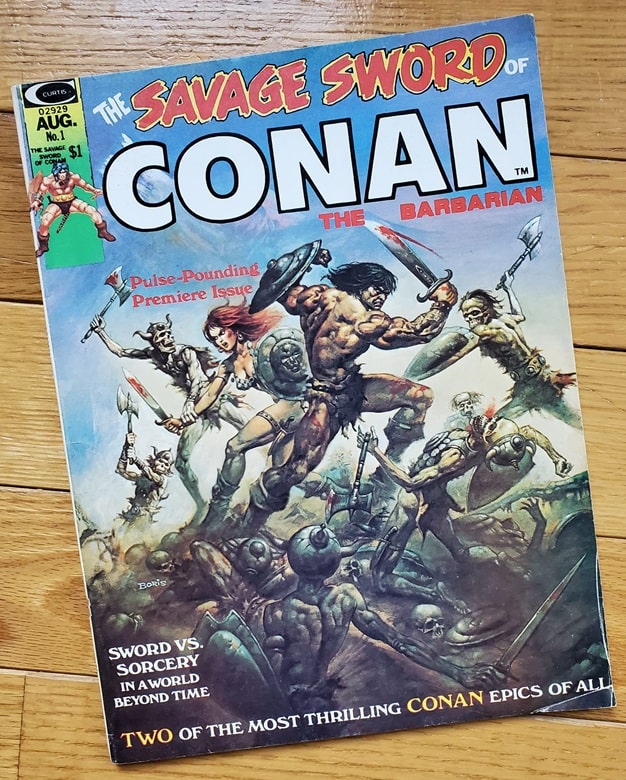
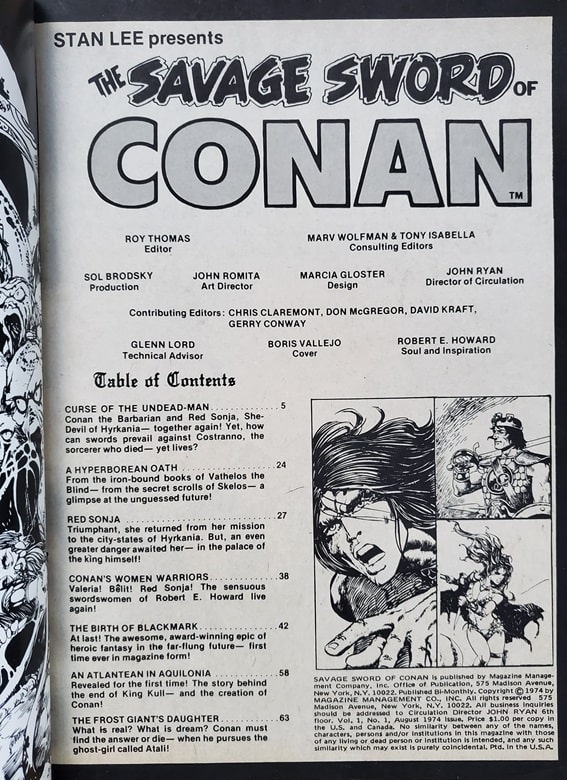
Savage Sword of Conan #1 (Marvel Comics, 1974). Cover by Boris Vallejo
The original Savage Sword of Conan #1 was published in 1974, featuring an incredible cover painting by Boris Vallejo (see above). It picked up where Savage Tales had left off, with Roy Thomas spearheading the efforts within.
The talent of the contributors is off the charts: John Buscema, Barry Smith, Alfredo Alcala, Gil Kane, Pablo Marcos, Esteban Maroto, Neal Adams, Ernie Chan, and a riveting article by Glenn Lord. All of it, as Roy Thomas states “… is dedicated to Conan and the other heroic-fantasy creations of the late Robert E. Howard (1906-1936).”
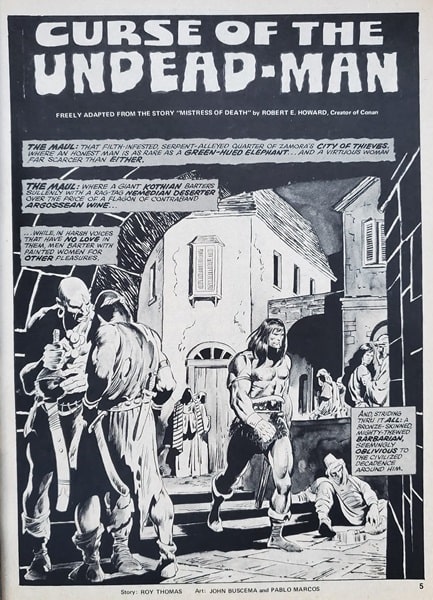
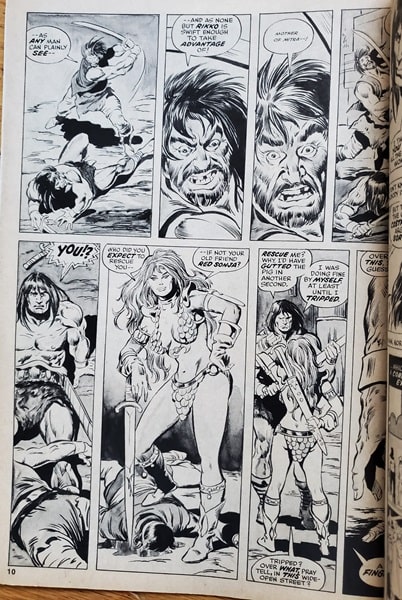
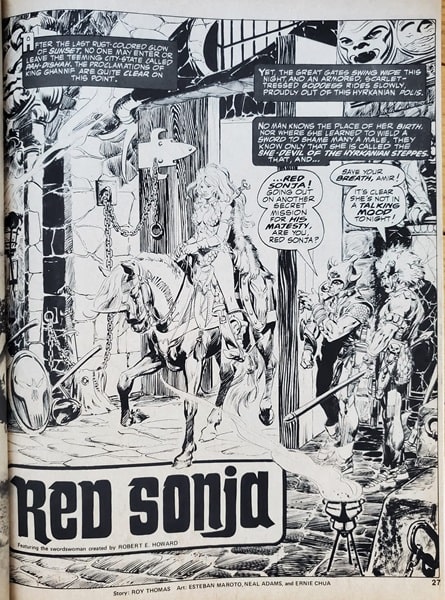
Interiors from Savage Sword of Conan #1 (Marvel Comics, 1974). Art by
John Buscema, Pablo Marcos, Esteban Maroto, Neal Adams, and John Chua
I already had a copy of this book, but I picked up this backup copy for $20 from my old pal, Chris, of Chris’s Comics.
For me, the most iconic Conan art was established by Frank Frazetta with his cover paintings on the Lancer paperbacks, and John Buscema with his cover and interior art in Marvel’s Conan the Barbarian and Savage Sword of Conan. When I was young, one of the things I always looked forward to was the next issue’s cover painting for SSoC.
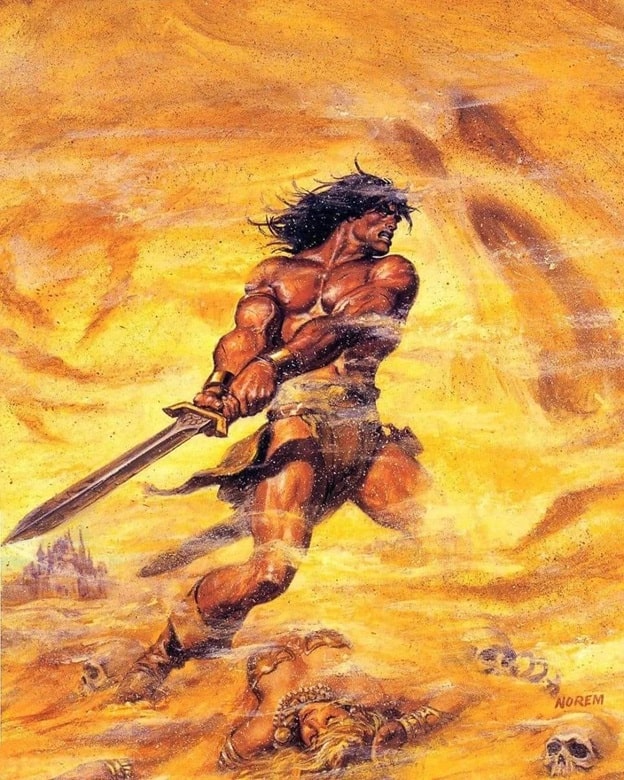 Cover art for The Savage Sword of Conan #54 (Marvel Comics, July 1980). Art by Earl Norem
Cover art for The Savage Sword of Conan #54 (Marvel Comics, July 1980). Art by Earl Norem
They rarely disappointed. Among those cover painting artists, one of my personal favorites was Earl Norem. I don’t believe he has received the attention he deserves for capturing incredibly dynamic scenes, such as the one pictured above, fighting a sand demon.
One of the prizes of my personal collection is the page below, purchased at a NY Comicon in the late 90s. This is an original page from Savage Sword of Conan #197, published in May, 1992.
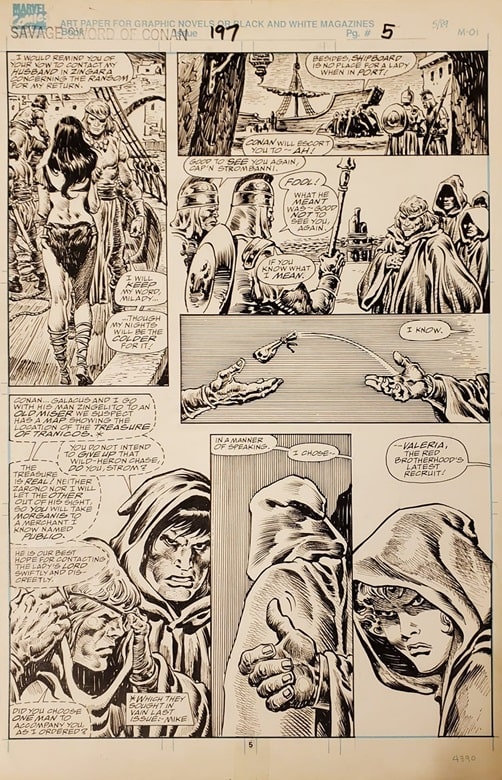 Original art from Savage Sword of Conan (Marvel Comics, May, 1992). Art by John Buscema and Ernie Chan
Original art from Savage Sword of Conan (Marvel Comics, May, 1992). Art by John Buscema and Ernie Chan
It features Roy Thomas writing, John Buscema pencils, and Ernie Chan inks. The ultimate creative dream team. On this page we see Conan, Belit, and Valeria. This is a one-of-a-kind piece that I will never part with!
One of the ultimate dream teams in comic book history was Roy Thomas, John Buscema, and Alfredo Alcala. The page below is from Savage Sword of Conan #20, adapting the Robert E. Howard story “The Slithering Shadow,” originally published in Weird Tales magazine in 1933. A sword-and-sorcery masterpiece.
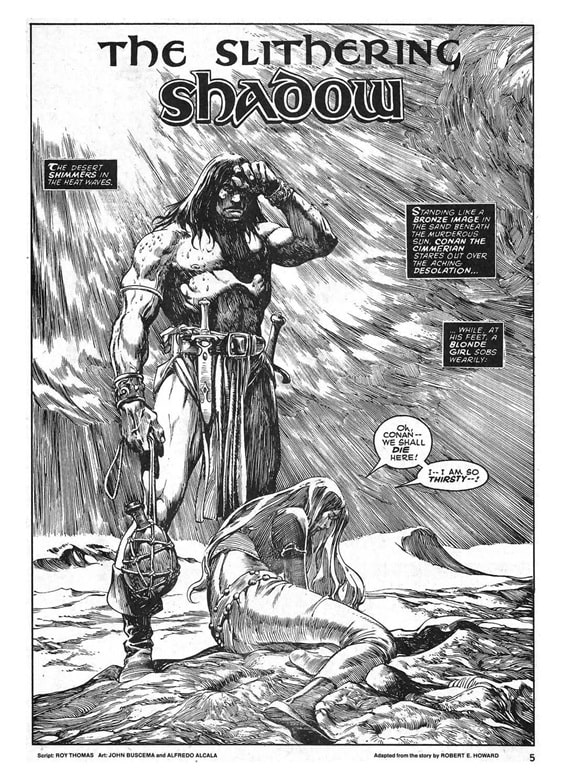 Splash page from Savage Sword of Conan #20, by Roy Thomas, John Buscema, and Alfredo Alcala (Marvel Comics, July, 1977)
Splash page from Savage Sword of Conan #20, by Roy Thomas, John Buscema, and Alfredo Alcala (Marvel Comics, July, 1977)
The third and final volume of Barbarian Life: A Literary Biography of Conan the Barbarian, by Roy Thomas, is a must-have for fans of Roy’s take on Robert E. Howard’s most famous character.
In thousands of four-color panels for Marvel Comics, Roy Thomas told the tale of Robert E. Howard’s greatest creation, Conan the Barbarian. Now, in this definitive biography and analysis, Roy chronicles Conan’s comic book life, issue by issue, plot by plot, and artist by artist.
For ten years, from October 1970 when Roy and artist Barry Smith assembled the first issue of Marvel’s Conan the Barbarian, to October 1980 when Roy and artist John Buscema completed their last issue together on the series, Thomas wrote of Conan’s gigantic melancholies and gigantic mirth — as well as the wars, the wenches, and the wizardry that bedeviled the Cimmerian from one issue to the next.
In this final volume of the series, Roy Thomas explains the creative process behind his final few issues of Conan the Barbarian, his run on King Conan, and selected stories published in Savage Sword of Conan. Additional features include a full-length interview with Roy, a short history of sword-and-sorcery in the comics, and the tale of Conan’s battles with the Comics Code.
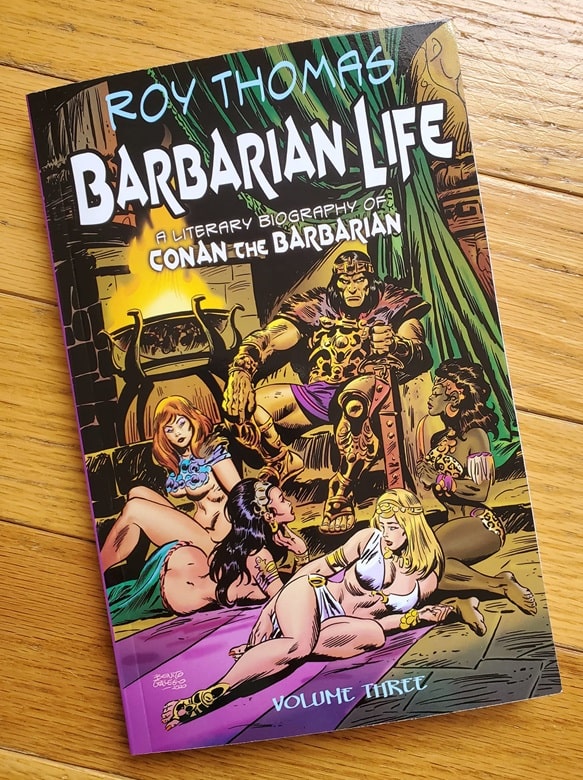 Barbarian Life: Volume Three: A Literary Biography of Conan the Barbarian by Roy Thomas (Pulp Hero Press, April 26, 2021)
Barbarian Life: Volume Three: A Literary Biography of Conan the Barbarian by Roy Thomas (Pulp Hero Press, April 26, 2021)
Now, I do want to preface what I am about to say by noting that my thoughts may be clouded by the nostalgia of my youth: lying on my bedroom floor, poring over my Conan comics and studying the words and art with rapt interest.
That being said, of all the pastiche authors who have developed new, original Conan tales, Roy Thomas may be my favorite — and he did it with the accompaniment of a brilliant visual medium, working with some of the finest artists of the day, such as the aforementioned Barry Smith and John Buscema, and also greats such as Alfredo Alcala, Gil Kane, and Ernie Chan.
Unfortunately, one of my favorite Conan artists, the incredible Val Semeiks, didn’t cross paths with Roy, but he deserves mentioning nonetheless for his breathtaking art.
Jeffrey P. Talanian’s last article for Black Gate was The Dreams in Gary’s Basement: Gary Gygax and the Creation of Dungeons & Dragons. He is the creator and publisher of the Hyperborea sword-and-sorcery and weird science-fantasy RPG from North Wind Adventures. He was the co-author, with E. Gary Gygax, of the Castle Zagyg releases, including several Yggsburgh city supplements, Castle Zagyg: The East Mark Gazetteer, and Castle Zagyg: The Upper Works. Read Gabe Gybing’s interview with Jeffrey here, and follow his latest projects on Facebook and at www.hyperborea.tv.
SPFBO X Finalist - Gates of Hope by J.E. Hannaford

ABOUT THE AUTHOR: J E Hannaford is powered by coffee, dragons and whisky. She teaches Biology in the real world and invents fantasy beasts to populate her own.
She lives in Suffolk, UK, and pines for the coast and mountains of Wales.
A love of nature and the ocean washes through the pages of J E Hannaford's stories and pours out of the characters who live in it.
Find J.E. online: website
Gates of Hope links: Amazon, Goodreads
ESMAY
Well, I don’t know what I was expecting from Gates of Hope, but I am pretty sure nothing could have prepared me for the wildly imaginative epic sci-fantasy adventure it turned out to be. It’s got dystopian landscapes and societies, completely unique flora and fauna, a magical academy and secret societies, at least six types of mystifying magic, planet hopping portals, and, hear me out, space dragons. What’s not to love… right?
From the very first page, I found J.E. Hannaford’s bold storytelling and rich prose to be incredibly immersive. Yes, we are dropped into quite a deep pool of unfamiliar fantasy terminology and complex history and lore, but the way that this entire world (or should I say universe?) unfolded through the three distinctly unique POV characters’ eyes felt wonderfully organic to me.
Whether it was Darin with his dream/song magic, dangerous secret society shenanigans, and newfound psychic moonhound bond (Star is the MVP!!), Suriin with her emotion magic and desperate lust for an adventure to take her outside the deep crater communities of Caldera, or the outcast Elissa all the way over on the moon of Tebein discovering outlawed magical powers that could save her entire race from the tyrannical rule of the alien awldrin overlords, if they don’t eliminate her first; I am not kidding when I say that every single chapter contained some type of new marvellous piece of revelatory world building that just filled me with awe.
However, as interesting and intriguing as I found the events unfolding throughout these characters’ increasingly wild lives, I have to admit that I never truly connected to any of them, and I soon found myself struggling to stay engaged by the almost slice-of-life storytelling. To me, Gates of Hope lacked a strong overarching conflict/plot pulling everything together into a cohesive whole, and it felt like everything was happening TO these characters rather than because they took any decision driven by personal motivations, which made it quite hard for me to really root for them.
Maybe I was just hoping and expecting this story to be something it was never meant to be, and ultimately I truly can’t deny that Hannaford’s ambitious vision for the Aulirean Cycle is beyond impressive. While this first book in the series failed to truly hook me at any point, I think the explosive ending showed a lot of potential and set up the sequel(s) in a very strong way. So, if you are looking for an exceptionally slow-burn and character-driven epic sci-fantasy adventure that is simply bursting with imagination, emotion, and heart, then I can’t recommend Gates of Hope highly enough.
ŁUKASZ
Sometimes, a book feels like it’s going somewhere, only for you to realize you’ve been waiting for things to happen and they still haven't. Gates of Hope is one of those books. It’s clear J.E. Hannaford poured her heart into building this world (interplanetary dragons, magical moonhounds, and a system of magic fueled by emotions and music), but all that effort doesn’t quite translate into an engaging story.
The premise is solid: a war-torn world, magical gates destroyed by a dragon, and three protagonists dealing with the fallout. But rather than picking up speed, the plot crawls. Elissa struggles under alien rule on one of the moons, Darin bonds with his moonhound while learning magic, and Suriin works on controlling her powers. They all have potential, but their stories don’t really connect, and for most of the book, it feels like nothing significant happens.
The pacing is the main culprit. It’s practically at a standstill for long stretches. The book spends so much time on small, everyday details and repetitive scenes that the plot barely gets a chance to move. Even when things finally pick up near the end, it feels too little, too late.
The characters also didn’t do much to save the story. While there’s some charm - Darin’s moonhound, Star, is a highlight - the protagonists themselves feel flat. Their personal growth and struggles should’ve been the heart of the story, but instead, it’s like watching three separate, slightly dull movies that never quite come together.
That said, the world-building is impressive. You can tell Hannaford put a lot of thought into creating her universe, and for readers who love rich, detailed settings, this might hit the spot.
If you’re patient and enjoy slow, slice-of-life fantasy, Gates of Hope might work for you. Otherwise, it’s a bit of a slog - a lovingly crafted world where not enough actually happens.
OFFICIAL SPFBO RATING

Delirium by Lauren Oliver (Delirium #1)
They say that the cure for Love will make me happy and safe forever.
And I’ve always believed them.
Until now.
Now everything has changed.
Now, I’d rather be infected with love for the tiniest sliver of a second than live a hundred years smothered by a lie.
Lena looks forward to receiving the government-mandated cure that prevents the delirium of love and leads to a safe, predictable, and happy life, until ninety-five days before her eighteenth birthday and her treatment, when she falls in love.
Rating: 4 Stars
Favorite Quotes:
But it does not tell you this: that love will turn the whole world into something greater than itself.
Love, the deadliest of all deadly things: It kills you both when you have it and when you don’t.
This is a dystopian book that’s a little different from The Hunger Games & Divergent and the like. The world isn’t ending, necessarily but the government has mandated that everyone over the age of 18 has a procedure that basically renders you incapable of love and most of the other strong emotions. They literally cut a piece out of the brain to achieve this! I cannot imagine a time when the majority of people would be pushing for this to happen, but here it does. I guess I can see some appeal to not suffering through a broken heart but to cut out a piece of my brain to achieve this? Uhhhh, no thank you!
The story follow Lena Haloway as she is preparing for her procedure. She got about 3 months until it is scheduled and there are interviews that have to be done so that the government can pick a husband suitable for her (because if you don’t care, how could you choose for yourself?) and what she will do for a living (will she go to college or just get a job until she is married?). They regulate the music that your allowed to listen to and the books that you can read. Something that Oliver did that is really different from most dystopian stories is the fact that everything we once had still exists. There are cell phones and cars and the internet. They are all strictly monitored and not everyone has them but they are still in use. So many times you read these types of books and its like living in the dark ages and I thought this was a nice touch.
One of my gripes about this book is that if you take away the portion of the brain that controls emotion, how does anything get done? If you don’t care, how do you take care of your children or get up everyday and go to work and cook and clean? Love guides almost all the things we do. We work because we love our families and want to take care of them. We love our children and so we play with them and discipline them and laugh with them. If you remove all those things are you really still alive? Aren’t other things in our lives determined by a type of love? If you were a police man breaking up an illegal party with a bunch of teenagers involved, would you care enough to just send them home or would you release the dogs against them and beat them with clubs and would it matter either way? Very confusing to me. I guess if love was that simple and it could be removed without interfering with everything else, then maybe, but it simply affects too many things.
Anyway, the story drags on a bit for me once the world is set up and you get a grasp on what’s happening. Lena and Hana (her best friend) start to break the rules and go to unauthorized parties after curfew. Up until this point, they’ve had almost no contact with the opposite sex besides adult males (parents and teachers who have all had the procedure) and these parties are full of uncured boy their own age. So in typical teenager fashion they are rebelling before they can’t anymore. Then Lena meets a boy, Alex, who shows her that there is so much to be missed by having the procedure done and how much the cureds have been lying to everyone (particularly Lena). As they get to know each other and fall in love Lena realizes that there’s no way she could ever willing have the procedure and she tries to come up with a way for them to escape.
Will they find a way or will Lena have to lose part of herself?
*SPOILERS BELOW*
First of all, I cannot believe that there wasn’t a love triangle in this book! It was kind of nice to not have to be vacillating between two love interests!
I was wondering throughout the whole beginning of the book if it wouldn’t turn out that Lena’s Mom was still alive. Considering how long ago she supposedly killed herself she was still very present in Lena’s mind and that usually means something is coming up. It’s too bad that she didn’t get to see her before she escaped though.
I cannot BELIEVE that Alex doesn’t make it with Lena to the Wilds! He sacrifices himself up to the regulators so that Lena can get away. He got shot and captured but I’m not sure if he’s alive or not! What will she do now in the Wilds all alone? Being with Alex was the main reason she decided to run away in the first place! Sheesh, I wonder what Oliver has planned for book 2?
Unravel Me by Tahereh Mafi (Shatter Me #2)
tick
tick
tick
tick
tick
it’s almost
time for war.
Juliette has escaped to Omega Point. It is a place for people like her—people with gifts—and it is also the headquarters of the rebel resistance.
She’s finally free from The Reestablishment, free from their plan to use her as a weapon, and free to love Adam. But Juliette will never be free from her lethal touch.
Or from Warner, who wants Juliette more than she ever thought possible.
In this exhilarating sequel to Shatter Me, Juliette has to make life-changing decisions between what she wants and what she thinks is right. Decisions that might involve choosing between her heart—and Adam’s life.
Rating: 4.5 Stars
Favorite Quotes:
My troubles have arrived fashionably late to this conversation, inconsiderate beasts that they are.
It’s the kind of kiss that makes you realize oxygen is overrated.
He’s standing right in front of me and I miss him like I haven’t seen him in years.
“I think there’s something about the impermanence of life these days that makes it necessary to etch ink into our skin,” he says. “It reminds us that we’ve been marked by the world, that we’re still alive. That we’ll never forget.”
Another heart wrenching book by Mafi. She really is a wonderful writer. I couldn’t put the book down. I devoured it in a day and now I’m dying to know what happens next. I’m not sure but I think this is a three book series so the next one should be the end. I love the way your heart is practically in your throat the whole book. There is so much emotion happening and Mafi writes in a way that you can’t help but experience everything along with the characters.
Book two picks up shortly after where book one ended. Juliette, Adam and James have been at Omega Point for about a week and things are starting settle down. Once the immediate danger is over Juliette has retreated back inside herself because she is now surrounded by people who know what she can do and some of them include children. She doesn’t want to scare anyone and so she decides to just keep to herself and only really talk to and associate with Adam. What a hard thing to have to experience at the age of 17, to try to make friends when you’ve never done something like that before. She’s always been immediately ostracized when she was around other people and so she doesn’t know how to start getting to know people. I thought this was a good road for Mafi to take with this story, it makes it more believable. Because of this, she comes off even scarier than she would have if she even made some small attempt to interact with people. The story about how she killed that little kid years ago gets out and now everyone is looking at her just like people always have. So much for being with people who would understand her because she wasn’t the only one with some bizarre powers. Castle thinks that there might be more to Adam being able to touch her than it just being some fluke and now he’s undergoing some test to see if there’s another reason he can touch her. The results are devastating and now Juliette has to decide how she’s going to back away from him to keep him safe. She learning more about her own abilities and now she’s not just worried about her touch being dangerous. Her whole body is a weapon and she has no control over it. On top of that monumental obstacle, she is still keeping secrets from Adam. She hasn’t told him that Warner can touch her too and that she kissed him right before she shot him. I don’t know why she doesn’t say anything. She should have told him as soon as he was healed. There was no real reason for her not to except for the part where she actually enjoyed it. She could leave that part out of it as far as I’m concerned but the rest of it she should have told him. You can’t keep secrets like that. The fact is that if they really loved each other there would be no reason to keep these kinds of secrets. Adam might be a little pissed but the fact is she did what she needed to do so that she could save him and I don’t think that he would be angry for long.
Kenji plays a much bigger role in this book and I’m so glad because I love him! He’s like the only bright spot in the book; his personality is so bright and carefree that you can’t help but smile when he’s around. This is not to say that he doesn’t have some serious moments and he does put Juliette in her place a few times but she really needed someone to kick her in the ass so she would quit moping around. The reality is that she is the primary reason that The Reestablishment is hunting so fiercely for Omega Point. Not that this wouldn’t have come to a head at some point in the future but the timetable’s been moved up and that is because of Juliette. Warner can’t let her go and now that his father is involved he hasn’t got a choice but to find her. After learning more about him in Destroy Me I was pretty sure he would be a big part of this book as well. We learned even more about him and his past as him and Juliette spend some time together.
Kenji has been working with Juliette to help her figure out and hone her skills and she starts to get a little more control of it. I was hoping this would naturally lend itself to help with her self-esteem but that doesn’t really happen. If she should would just accept who and what she is life would start to become more manageable for her but she can’t stop seeing herself as a monster. She’s come out of her shell a little bit and it starting to make some friends but everyone at Omega Point is preparing to battle Warner’s father and his men and they need Juliette to help them. With the strength of her power she could be the edge that they need to win.
Will she be able to put her personal feelings aside and focus on the more important objective? Will she be able to use her abilities against the “bad guys” to save the innocent citizens of sector 54? How will she reconcile her feelings for Adam and Warner?
*SPOILERS BELOW*
Oh man this book was torture for me! I’m still so unsure who I want Juliette to end up with! Her and Adam have such an intense relationship and it’s been growing since they were kids. Now that they have finally found each other and Adam can actually touch her things were looking up. This was not to last, of course, and now Adam has discovered that he has an ability as well. He’s a disruptor and that’s why he can touch her because he can cancel out her power. The problem with this is that he has to be constantly on guard in order for it to work and that can’t happen when they are getting physical with each other. She nearly kills him at one point! So she’s decided to stay away from him and it’s destroying both of them. Then there’s Warner. This is the first time that Juliette really gets to know him for who he is instead of the leader of sector 54. When she was listening to his father tear him down and then again later when he was being held captive at Omega Point and she had to interrogate him. He was so sweet to her and let her see a part of himself that I don’t think he’s ever shown anyone else. The scars on his back, the way he really sees himself, the way he sees her and how she makes him feel. It was breathtaking to witness. Now she’s so confused about what to do and she hasn’t told Adam about any of this and she hasn’t told Warner that Adam is his brother (which shocked the hell out of me, by the way) and she’s somehow in the middle and unable to decides what to do. She’s also hiding a lot of information about Warner. She doesn’t tell anyone that she knows why he can touch her and what his ability is and I’m not sure why. What could it harm? It just makes her look worse for keeping it to herself. I think she loves them both but who is the better choice? Adam is so loving and caring and wants to take care of her and he loves her with a desperation that is a little frightening. Warner can be gentle and caring and he doesn’t pull any punches. He is who he is and he accept Juliette for who she is and what she is capable of. He also loves her in an overwhelmingly obsessive way. I wonder if this is something about Juliette or if it’s something in their DNA that she attracts? Either way it’s a tough decision.
I wish that Kenji wouldn’t have stopped Juliette from killing Anderson. That guy is a monster and someone needs to take care of him. I understand why he did it but at the same time you don’t go to war with someone in his position if you don’t have his replacement ready to take over. Then in the end when he just shot her in the chest and leaves! This was the only real issue I had with the book. Why would he have gone through the trouble of shooting her in front of Warner only to leave before he could witness what it did to him? And, why would he have had “the girls” kidnapped to use to heal him only to leave them behind? If anything, he should have at least taken them with him back to the capital.
I’m really looking forward to seeing how it all ends.
Destroy Me by Tahereh Mafi (Shatter Me #1.5)
Perfect for the fans of Shatter Me who are desperately awaiting the release of Unravel Me, this novella-length digital original will bridge the gap between these two novels from the perspective of the villain we all love to hate, Warner, the ruthless leader of Sector 45.
In Tahereh Mafi’s Shatter Me, Juliette escaped from The Reestablishment by seducing Warner—and then putting a bullet in his shoulder. But as she’ll learn in Destroy Me, Warner is not that easy to get rid of. . .
Back at the base and recovering from his near-fatal wound, Warner must do everything in his power to keep his soldiers in check and suppress any mention of a rebellion in the sector. Still as obsessed with Juliette as ever, his first priority is to find her, bring her back, and dispose of Adam and Kenji, the two traitors who helped her escape. But when Warner’s father, The Supreme Commander of The Reestablishment, arrives to correct his son’s mistakes, it’s clear that he has much different plans for Juliette. Plans Warner simply cannot allow.
Set after Shatter Me and before its forthcoming sequel, Unravel Me, Destroy Me is a novella told from the perspective of Warner, the ruthless leader of Sector 45
Rating: 5 Stars
Favorite Quotes:
It’s a strange thing, to never know peace. To know that no matter where you go, there is no sanctuary. That the threat of pain is always a whisper away.
Love is a heartless bastard. I’m driving myself insane.
I’m at a loss for words with this novella. At the end of Shatter Me I had already firmly decided that I didn’t like Warner. I didn’t necessarily think he was a bad person, per se, but that he wasn’t a good person either. Now I find myself saddened by his story. Raised by a man who never had a nice thing to say to him and never receiving any kind of affection. It’s very similar to Juliette’s story, really, only that in Warners situation it wasn’t because people couldn’t touch him but because no one did. It makes a lot more sense now why he felt to connected to Juliette and now that he has her journal from when she was institutionalized he’s even more determined to find her and bring her back to be with him. I’m not sure if he’s going to have much success with this due to the way he tried to get her affections the last time but I at least have a better feel for who he is and why he is the way he is. I think that anyone can change, given the proper motivation. The question is, will Warner want to change and is love enough of a motivator for him? I think we’ll find out in book two which is next up on the list.
Shatter Me by Tahereh Mafi (Shatter Me #1)
Juliette hasn’t touched anyone in exactly 264 days.
The last time she did, it was an accident, but The Reestablishment locked her up for murder. No one knows why Juliette’s touch is fatal. As long as she doesn’t hurt anyone else, no one really cares. The world is too busy crumbling to pieces to pay attention to a 17-year-old girl. Diseases are destroying the population, food is hard to find, birds don’t fly anymore, and the clouds are the wrong color.
The Reestablishment said their way was the only way to fix things, so they threw Juliette in a cell. Now so many people are dead that the survivors are whispering war– and The Reestablishment has changed its mind. Maybe Juliette is more than a tortured soul stuffed into a poisonous body. Maybe she’s exactly what they need right now.
Juliette has to make a choice: Be a weapon. Or be a warrior.
Rating: 4.5
Favorite Quotes:
Truth is a jealous, vicious mistress that never ever sleeps, is what I don’t tell him. I’ll never be okay.
my cheek is pressed against his chest and he smells like strength and courage and the wold is drowning in rain.
I remember you every day forever in every single broken moment of my life.
His hands are shaking so slightly, his eyes brimming with feeling, his heart thrumming with pain and affection and I want to live here, in his arms, in his eyes for the rest of my life.
I wasn’t sure what to expect from this book when I first picked it up. It was a recommendation from a friend and I thought, what the hell, I’d give it a shot. It was surprisingly good! The writing style took a little getting used to as most of what Juliette thinks is in run on sentences. This makes a little more sense once you figure out that she has been locked up all alone for almost a year and hasn’t spoken to another living soul for that whole time. I think I’d be a little nutty too. Mafi is a very emotionally descriptive writer and because of this it doesn’t take very long for you to be attached to certain characters and to really despise others. I only used four of my favorite lines from this book above but I think I highlighted around 10 or so which is really high for me in any book. I think she’s an amazing writer and once I got used to her writing style, I really liked it.
I’m not sure what year the book is set in but basically we’ve destroyed the planet and there’s not enough food or clean water and The Reestablishment has taken over power of everyone. They’ve decided that in order to correct the problems that society has caused they need to make several changes. Only the strong get to survive, they are getting rid of all the books they can find and trying to create a whole new language. All the unhealthy, weak and old are gotten rid of. It doesn’t specifically say how this happens maybe they are all killed or maybe they are just segregated from the rest of society? Juliette has some sort of weird power where it is dangerous for her to touch anyone. She had an incident in a grocery store and after that she was locked up in what she assumes is an insane asylum. One day she gets a cell mate, Adam Kent, and then things start to change a little for her. Can you imagine not speaking to anyone for a year? Just as she’s starting to get used to the idea of him she’s taken out of her cell and introduced to the sector leader for The Reestablishment, Warner, who informs her that he’d like her to join their cause. He thinks that her “talent” could be really useful to them. Which means, of course, that he would like her to help him kill the rebels. Warner takes her to their base and sets her up with a nice room and nice clothes and good meals and thinks that this is the way to get her to agree to join him. He’s got more on his mind than just how she can help their cause too. Luckily for her, people can’t touch her (at least not most people) so she seems to be relatively safe for the time being.
Adam has been assigned to guard her and as time goes on we learn a little about their past and get to see their relationship develop into something very sweet and intense. Juliette’s got to escape from The Reestablishment, especially from Warner as he’s got some kind of weird obsession with her, and Adam is going to help her to this. When they finally get free, it’s a mad dash to find their allies and get somewhere safe. Then everything gets turned on its head when they do finally find safety. Will this new group be the good guys? Will they want to use Juliette for her “talents” as well? With her suddenly being in a situation of acceptance, how will she handle it and will her and Adam be able to stay together?
*SPOILERS BELOW*
I love the relationship between Adam and Juliette. I wasn’t sure how this would work out in the beginning, since she can’t be touched and was relieved that Adam was the exception to this rule. The fact that they knew each other when they were younger went a long way with me to support the intensity of their feelings for each other. You can’t just meet someone and all of a sudden be in love with them. I liked that they each had formed feelings for the other growing up even though they had never had a conversation before now. Adam is so sweet to her and the fact that he remembered all the small things she did growing up for the same people who treated her so terribly was a nice touch. I’m not sure how this will all play out as Juliette has no experience with relationships of any kind. How will she handle something so intense?
I was disappointed to learn that Adam wasn’t the only one immune to Juliette’s dangerous touch when Warner touched her right before they escaped. I’m not sure exactly how I feel about Warner. I think that he is a product of his upbringing. Even though he can be ruthlessly cold and calculated, I’m not sure that he is a bad person. I think this is all he knows. He seems to have real feelings for Juliette although they way he got to know her was a little stalkerish with reading all about her history and then watching her in the asylum for the past year. He’s obsessive though and he’s not going to just let her go without some sort of fight.
I actually really loved the ending to this book! I totally didn’t see it coming. A whole group of people who all have different abilities. How wonderful for Juliette to finally feel like she belongs somewhere. Adam made a little headway with her self-esteem over the course of the few months they got to spend together but think about how horrible her life would have been. Can you imagine not being touched by anyone for almost your entire life? It’s pretty incredible that she’s still such a good person. The kind of power that she has would have been so dangerous in the wrong hands. The way her parents made her feel like a monster especially pissed me off. As a parent you love your children NO MATTER WHAT and how could you let her feel so alone her whole life? They could have ruined her forever. I’m excited to see what book two brings. I’d like to know what other kind of gifts the people of Omega Point have and how they deal with Warner and the threat he represents.
Next up is Destroy Me, a novella before Unravel Me.





Recent comments